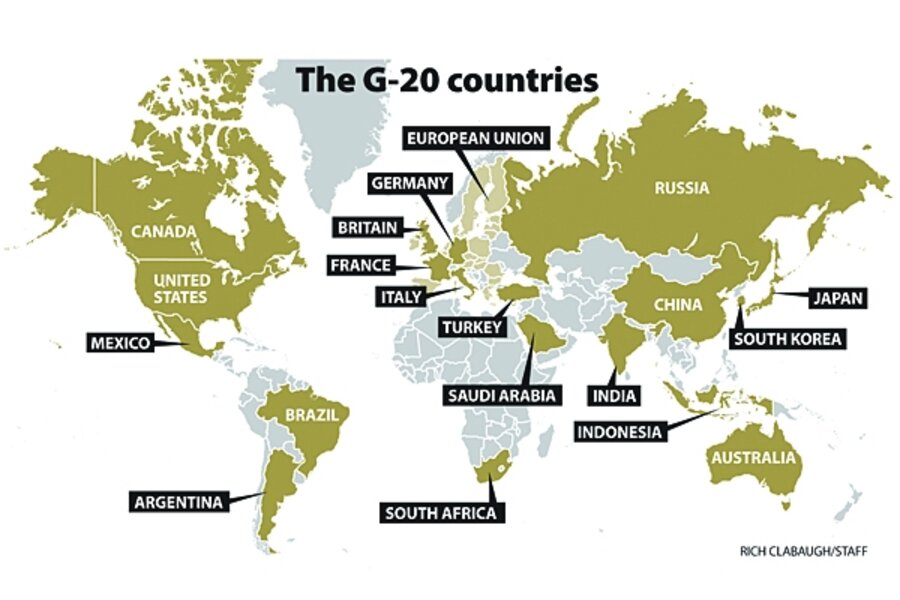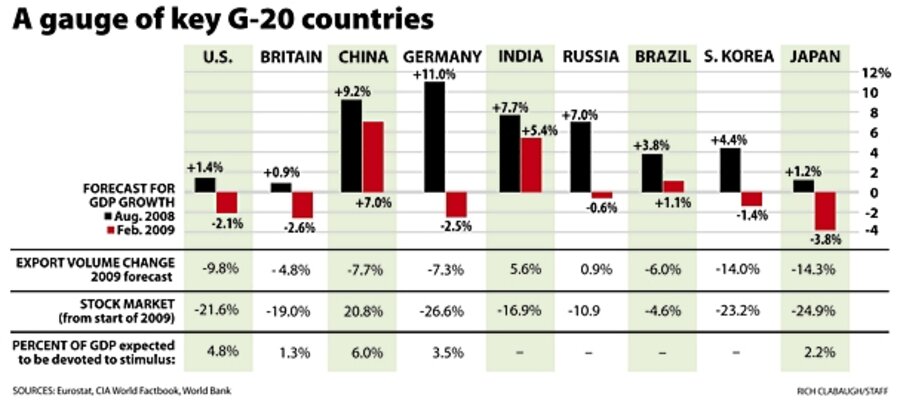Behind the G-20: A primer
Loading...
Why not G-203?
Although the planet is covered by 203 officially recognized sovereign nations – depending on who’s doing the recognizing – the world’s 19 largest economies, plus the European Union and the leaders of major international financial institutions, make up the G-20.
Formally known as the Group of 20 Finance Ministers and Central Bank Governors, the G-20 economies comprise 85 percent of global gross domestic product.
What’s the idea behind the meeting?
Apart from saving the world from the so-called Great Recession, G-20 leaders also hope to come up with a solution to global warming and find better ways to further international development.
Seriously. That’s the stated goal on the group’s website.
With the meeting lasting just over a day (starting with state dinners and royal schmoozefests Wednesday evening), there’s some doubt that all those issues will be addressed in a meaningful fashion.
The major focus, of course, is the economy. According to the group’s website: “The G-20 will need to send a strong signal that it is prepared to take whatever further actions are necessary to stabilise the financial system and to provide further macroeconomic support.”
In short, the leaders of these powerful economies want to project a message that something is being done.
Has this been attempted before?
In June 1933, representatives from 66 countries met in London in hopes of stopping the Great Depression. They met for six weeks before giving up.
Some historians say their efforts were effectively torpedoed by US President Franklin D. Roosevelt, who refused to allow US officials to participate in negotiations aimed at stabilizing currencies.
The US, France, and Britain ended up taking different courses to address the Depression. Historian Patricia Clavin, of Jesus College at Oxford University in Britain, told the Associated Press that acrimony over the failed 1933 conference might have fueled Nazi Germany’s expansionist ambitions.
“The fact that the whole thing was played out in public meant that Germany also knew there was very little cooperation between Britain and the United States,” says Ms. Clavin, author of “The Great Depression in Europe, 1929-1939.”
“That was the potential combination which they knew would be very dangerous to German ambitions. And when they saw the US and Britain couldn’t get on, they said, ‘Hey, great.’ ”
What are the prospects for this summit?
Although leaders this week will no doubt be projecting images of unity, a serious and growing rift has emerged between the approaches of the US and Europe in dealing with the crisis. Britain and the US are calling for more money to be spent to stimulate economic recovery, while Germany and France want to see more regulation of banks and financial industries.
On Tuesday, according to the BBC, French President Nicolas Sarkozy said he would walk out of the conference if no progress were made to better regulate financial institutions in the future. “The crisis is too serious for us to hold a summit for nothing,” Mr. Sarkozy said.
Will personalities get in the way of progress?
Press accounts paint a picture that sounds more like a high school drama production than a gathering of an elite leadership club.
Perhaps the most colorful example is Sarkozy – dubbed “the ultimate Little Big Man” by the Guardian – who is reportedly being shunned by the Chinese after meeting with the Dalai Lama last year. He, like other European leaders, is expected to elbow his way closer to President Barack Obama.
German Chancellor Angela Merkel, meanwhile, could clash with Mr. Obama as the “stimulate vs. regulate” rift intensifies. Many will also be watching for signals of a thaw between the US and Russia.
The star, however, will be Obama (“of course,” says the Guardian). This is his first transatlantic trip and biggest foreign policy event yet.
We haven’t even mentioned Michelle, who will be received, along with her husband, by the queen of England Wednesday evening. Will she steal the show, as Carla Bruni did when she captivated hearts on her trip to Britain with husband Nicolas Sarkozy?
It appears that she has already begun to win Europe over, with the British press abuzz about her style after her arrival in London Wednesday. The London Evening Standard dubbed her arrival a "razzle dazzling performance," while others gushed about her sophistication and her choice of clothing and colors.






